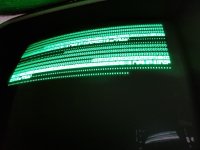Gary C
Veteran Member
ok, so no activity on ESD0 is expected.
| VCF West | Aug 01 - 02 2025, | CHM, Mountain View, CA |
| VCF Midwest | Sep 13 - 14 2025, | Schaumburg, IL |
| VCF Montreal | Jan 24 - 25, 2026, | RMC Saint Jean, Montreal, Canada |
| VCF SoCal | Feb 14 - 15, 2026, | Hotel Fera, Orange CA |
| VCF Southwest | May 29 - 31, 2026, | Westin Dallas Fort Worth Airport |
| VCF Southeast | June, 2026 | Atlanta, GA |
Does look very similarLooks a bit like the issue I had with one of the video RAM chips being to slow to respond, but on the EVEN side (if your PET is like mine)... check here mabye? https://forum.vcfed.org/index.php?threads/cbm-pet-8032-not-booting.1238362/page-2#post-1255666
What I was thinking was removing the character generator and linking the data outputs from the character generator (that feed the parallel to serial shift register) to defined states of 0V and +5V (via a resistor of course). This should result in a stable vertical line pattern (replicated for each character position) on the screen.and the char rom is in a socket, did you have an idea ?
As its an SK, the case opens from the back, so the monitor is facing away from me and balanced against a boom handle and the wall, so it was videoed with the front facing camera, which of course makes a mirror image.I just noticed that the characters in your video are mirrored.. is this your camera or does it really look like that?

Ah, so the characters after the b & g are ASCII of the number read back from the DRAM. Strange that they increment by 1 ?
I think it is failing because main RAM (low 16K) has bit 7 permanently at a '1'.
I think it has stopped at the 'fill the RAM with $00, $01, ... $FF and verify that we can read the same back' test.
If it doesn't read the correct pattern back, it displays the character that it found.
In this case, all of the characters in error that are displayed are inverse video - signifying that bit 7 is set when it shouldn't be.
It could either be a DRAM chip, or it could be one bit of a data buffer. I would go on probabilities though and go for the DRAM chip.
Excitement over, back to reviewing documents...
Dave
